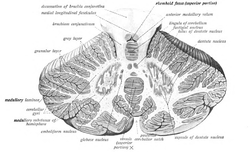The emboliform nucleus is a deep cerebellar nucleus that lies immediately to the medial side of the dentate nucleus, partly covering its hilum. It is one of the four pairs of deep cerebellar nuclei, which are from lateral to medial: the dentate, emboliform, globose and fastigial. These nuclei can be seen using Weigert's elastic stain.
| Emboliform nucleus | |
|---|---|
 Cross-section of the cerebellum. Emboliform nucleus labeled at bottom-left. | |
| Details | |
| Identifiers | |
| Latin | nucleus emboliformis |
| NeuroNames | 688 |
| NeuroLex ID | birnlex_1135 |
| TA98 | A14.1.07.409 |
| TA2 | 5838 |
| FMA | 72538 |
| Anatomical terms of neuroanatomy | |
In lower mammals the emboliform nucleus appears to be continuous with the globose nucleus, and these are known together as the interposed nucleus.[1]
Emboliform, from Ancient Greek, means "shaped like a plug or wedge".
Structure
editThe emboliform nucleus is a wedge-shaped structure of gray matter found at the medial side of the hilum of the dentate nucleus. Its neurons display a similar structure from those of the dentate nucleus. In some mammals the emboliform nucleus is continuous with the globose nucleus, forming together the interposed nucleus. When present, the interposed nucleus can be divided in an anterior and a posterior interposed nucleus, considered homologues of the emboliform and globose nuclei, respectively.[1]
Function
editThe emboliform participates in the spinocerebellum, a system that regulates the precision of limb movements.[2] Axons leaving the emboliform exit through the superior cerebellar peduncle and reach the red nucleus in the midbrain and several thalamic nuclei which project into areas of the cerebral cortex that control limb movement.[3][2]
References
editThis article incorporates text in the public domain from page 796 of the 20th edition of Gray's Anatomy (1918)
- ^ a b Carpenter, Malcolm B. (1985). Core text of neuroanatomy (3rd ed.). Baltimore: Williams & Wilkins. p. 207. ISBN 0683014552.
- ^ a b Kandel, ER.; Schwartz, JH.; Jessel, TM. (2000). Principles of Neural Science (4th ed.). McGraw-Hill Medical. pp. 843. ISBN 978-0838577011.
- ^ Subramony, SH.; Dürr, A. (2011). Ataxic Disorders, Volume 103: Handbook of Clinical Neurology (1st ed.). Elsevier. p. 26. ISBN 978-0444518927.
External links
edit- https://web.archive.org/web/20150621011739/http://www.mona.uwi.edu/fpas/courses/physiology/neurophysiology/Cerebellum.htm
- https://web.archive.org/web/20080405060224/http://www.lib.mcg.edu/edu/eshuphysio/program/section8/8ch6/s8ch6_30.htm
- NIF Search - Emboliform Nucleus via the Neuroscience Information Framework